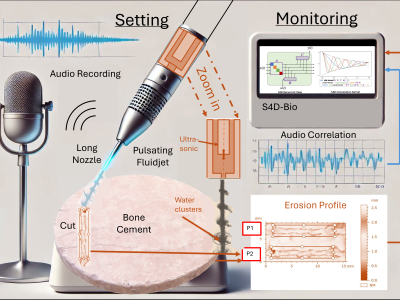Bone Cement Removal with Audio-Monitoring and Erosion Depth

- Citation Author(s):
- Submitted by:
- Melanie Schaller
- Last updated:
- DOI:
- 10.21227/exgn-g921
- Data Format:
 204 views
204 views
- Categories:
- Keywords:
Abstract
This dataset comprises extensive multi-modal data related to the experimental study of ultrasonically excited pulsating fluid jets used for bone cement removal. Conducted at the Institute of Geonics, Ostrava, Czech Republic, the study explores the effect of varying standoff distances on erosion profiles, under controlled parameters including a fixed nozzle diameter, sonotrode frequency, supply pressure, and robot arm velocity. The dataset includes numerical data representing ablation profiles, captured as a large CSV file, and audio recordings captured using a high-resolution microphone. Ablation profiles are measured at standoff distances that span several discrete lengths, ensuring diverse sample conditions. The audio data derives from high-fidelity recordings at a 38.4 kHz sampling rate in .wav format, capturing the fluid jet's impact sounds as it interacts initially with a metal plate and subsequently with the bone cement. This audio information was processed into Mel Spectrograms, which efficiently capture the frequency distribution crucial for predictive analysis. The dataset is organized into training and testing subsets, with the initial portions used to train predictive models leveraging Mel Spectrogram inputs to predict erosion profiles. This dataset offers insights into the dynamic interactions between a pulsating fluid jet and target materials, providing a foundation for predictive modeling in non-invasive surgical procedures.
Instructions:
1. Accessing the Dataset: The dataset can be downloaded from the provided repository link. It includes both the numerical ablation profile data in a CSV file as well as the processed audio data files in .wav format. Ensure you have sufficient storage space, as the files are sizable. Please also ensure to synchronize the .wav files with the time of the erosion profile data. Note that only the bone cement cutting sequences are used (orange parts in the Mel Spectrograms), while the material interaction with aluminium is also left in the audio files. 2. Software Requirements: To use this dataset effectively, install software capable of handling CSV files and audio data, such as Python with libraries like Pandas and Librosa. 3. Data Loading and Preprocessing: - Load the CSV file into a data analysis tool like Pandas for handling and manipulation of ablation profile data. The CSV file containing the ablation profiles has dimensions of [1150, 70], which means it contains 1150 rows and 70 columns. Please note that between the two erosion profiles that are interconnected to the audio data, there is one empty column to seperate the samples, which makes a total of 71 columns. Every erosion depth measurement was taken continuously and repeated 5 times to see the variation. - Import audio data using a library like Librosa, and preprocess it into Mel Spectrograms if needed. This involves setting the appropriate sampling rate and configuring the number of Mel frequency bins. The sampling rate is 38.4 kHz. This means that the audio waveform was sampled 38,400 times per second during the recording process. The number of Mel bins is 60. 4. Data Analysis and Model Training: - Begin with exploratory data analysis on the ablation profile data to understand variable distributions and relationships. - For the audio data, visualize the Mel Spectrograms to inspect the frequency components, which can help in feature extraction. - Use standard machine learning frameworks such as TensorFlow or PyTorch to build predictive models. The initial 50% of data is designated for training, optimizing model parameters with a suitable loss function like Mean Squared Error (MSE). 5. Model Testing and Evaluation: - Once the model is trained, use the remaining 50% of the data for testing. Provide only audio data to the model while withholding erosion profiles to evaluate prediction accuracy. - Compare the model's predictions against the actual erosion profiles using statistical metrics such as MSE to measure performance and calculate the accuracy based on a margin of +/- 1 µm









Submission of the original dataset to the paper: "S4D-Bio Audio Monitoring of Bone Cement Disintegration
in Pulsating Fluid Jet Surgery under Laboratory Conditions", by the authors: Melanie Schaller (0000-0002-5708-4394), Sergej Hloch (0000-0003-4066-0620), Akash Nag (0000-0003-0400-7739), Dagmar Klichova (0000-0002-7135-7141),Nick Janssen (0009-0006-4372-8466), Frank Pude (0009-0005-5837-5037), Michal Zelenak (0000-0002-3066-3097) and Bodo Rosenhahn (0000-0003-3861-1424 submitted to Computers in Biology and Medicine (CIBM), Elsevier. The paper references will be updated.